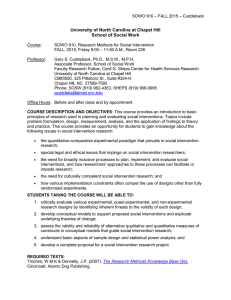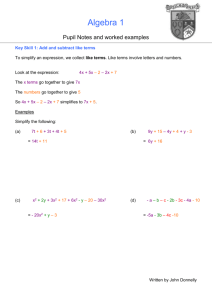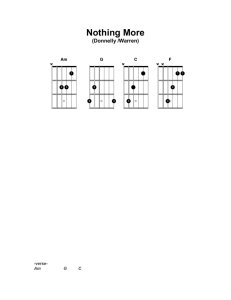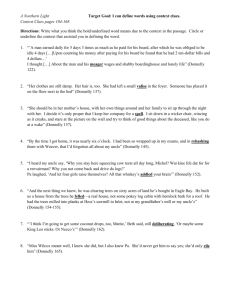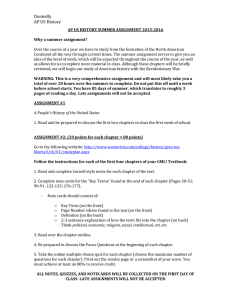T U N C
advertisement
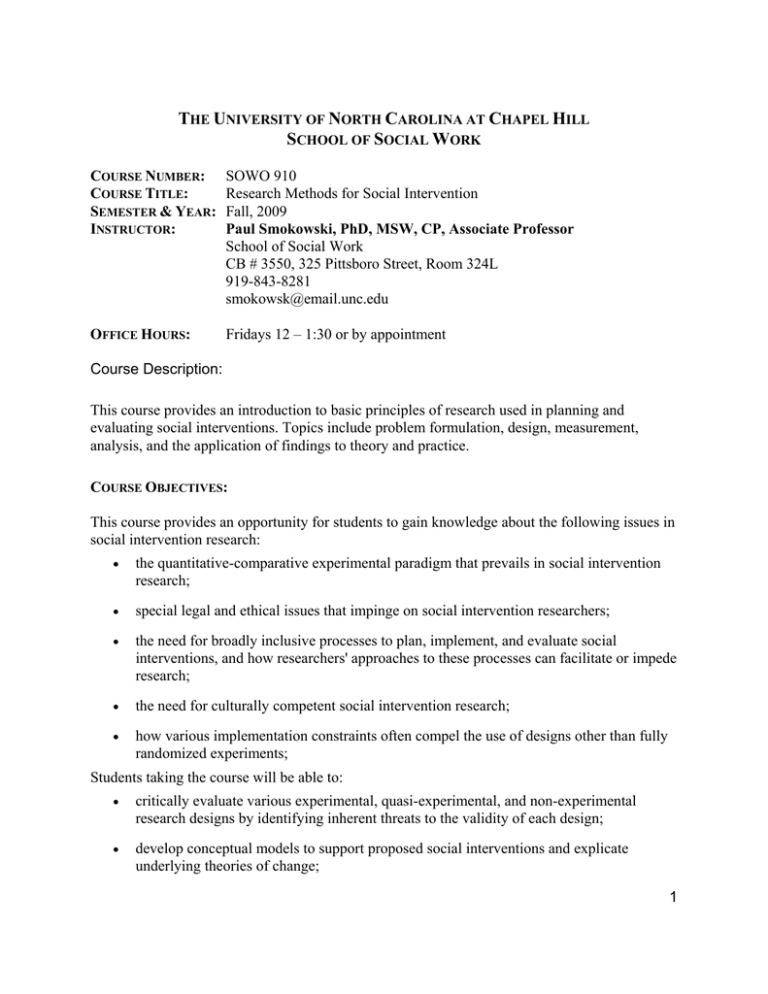
THE UNIVERSITY OF NORTH CAROLINA AT CHAPEL HILL SCHOOL OF SOCIAL WORK COURSE NUMBER: COURSE TITLE: SEMESTER & YEAR: INSTRUCTOR: SOWO 910 Research Methods for Social Intervention Fall, 2009 Paul Smokowski, PhD, MSW, CP, Associate Professor School of Social Work CB # 3550, 325 Pittsboro Street, Room 324L 919-843-8281 smokowsk@email.unc.edu OFFICE HOURS: Fridays 12 – 1:30 or by appointment Course Description: This course provides an introduction to basic principles of research used in planning and evaluating social interventions. Topics include problem formulation, design, measurement, analysis, and the application of findings to theory and practice. COURSE OBJECTIVES: This course provides an opportunity for students to gain knowledge about the following issues in social intervention research: the quantitative-comparative experimental paradigm that prevails in social intervention research; special legal and ethical issues that impinge on social intervention researchers; the need for broadly inclusive processes to plan, implement, and evaluate social interventions, and how researchers' approaches to these processes can facilitate or impede research; the need for culturally competent social intervention research; how various implementation constraints often compel the use of designs other than fully randomized experiments; Students taking the course will be able to: critically evaluate various experimental, quasi-experimental, and non-experimental research designs by identifying inherent threats to the validity of each design; develop conceptual models to support proposed social interventions and explicate underlying theories of change; 1 assess the validity and reliability of alternative qualitative and quantitative measures of constructs in conceptual models that guide social intervention research; understand basic aspects of sample design and statistical power analysis; and, develop a complete proposal for a social intervention research project. Recommended Prerequisites SoWo 102 or equivalent SoWo 292 or equivalent REQUIRED TEXTS/READINGS: Trochim, W.M.K & Donnelly, J.P. (2007). The Research Methods Knowledge Base (3e). Cincinnati: Atomic Dog Publishing. Simply go to the following website and follow the ordering instructions: http://www.atomicdog.com Used copies of the text also are available from Amazon.com and other bookstores RELATED READINGS: Related readings outside of the textbook are listed in the course outline and are assigned at the instructor’s discretion. TEACHING METHODS The development of a supportive learning environment, reflecting the values of the social work profession, is essential for the success of this class. A supportive learning environment is fostered by listening to the ideas and views of others, being able to understand and appreciate a point of view which is different from your own, articulating clearly your point of view, and linking experience to readings and assignments. I will appreciate your contributions to making this a safe and respectful class for learning and growth. 2 CLASS ASSIGNMENTS SEMINAR PARTICIPATION 1. Enroll in CoS. Make yourself known to potential collaborators by registering as a member of the Community of Science. September 4 2. Identify funding resources. Become familiar with sources of information about obtaining financial support for your research. September 4 3. Obtain Certification in Protection of Human Participants: Students must complete the on-line course developed by the Collaborative IRB Training Initiative (CITI) to certify that they are familiar with the ethical principles and guidelines governing research involving human participants; completing the course requires several hours; each student is required to bring a completion certificate to class on September 11 (this assignment is required, but is not graded). 4. Participate in seminar: Students are expected to read assignments and come to class prepared to ask questions and to respond to questions about the material. Each student should prepare a 1-page self-evaluation of his or her efforts to make this a productive learning experience and award yourself 1-10 points for those efforts (see description of grading). This is due the last day of class (December 4th) and should be submitted to the instructor by email. WRITING ASSIGNMENTS The ultimate objective of writing assignments in this course is for each student to produce a research proposal. During the semester, you will write a series of four 5-8 page papers, each related to a component of the final proposal. Preparing the final proposal will require revision and expansion of the preliminary draft sections, as well as additional sections. For this overall assignment, you will respond to PA-07-002 http://grants.nih.gov/grants/guide/pa-files/PA-07-002.html as if you were preparing to submit a Predoctoral Fellowship Application to NIH. This PA will help you with the training plan piece of the proposal. The other pieces are broken down during the semester. You will submit to the instructor polished drafts of the following pieces. 1. Conceptual Framework: After meeting with the instructor to discuss preliminary ideas, each student will identify a topic for a proposal to evaluate the effects of a social intervention. The assignment requires that you conduct a rapid assessment of literature in your area of interest and construct a conceptual framework to guide the research. This paper, including text and a diagram depicting the framework, will be due September 18. 2. Assessing Measurement Alternatives: A second paper requires that you identify and assess the relative strengths and weaknesses of alternative measures of (or approaches to measuring) a single theoretical construct identified in your conceptual framework. The 3 purpose of the exercise is to select the measure (or set of measures) that will yield the most valid and reliable data concerning this construct. This paper will be due October 2. 3. Research Design: Based on your chosen topic, you will outline the basic features of an experimental or quasi-experimental design for evaluating the impact of a social intervention on specific outcomes. The description should identify key research questions, the unit(s) of analysis, and how threats to the validity of the research will be controlled. If necessary, the discussion should provide a rationale for using an approach that deviates from a true experimental design and describe how concessions to design constraints make the research vulnerable to criticism. This 5-8 page paper will be due October 30. 4. Sample Design and Power Analysis: After describing the relevant research population and sampling procedures, you will prepare a statistical power analysis using key independent and dependent variables related to your research. You can use Web-based programs or commercial software for this exercise. The product will be a brief discussion with tables summarizing the results of your analysis and a recommendation concerning sample sizes that would provide adequate power for the proposed research. This paper will be due November 13. 5. Research Proposal: This assignment is the culmination of your work in this course. We will discuss the format and content of the proposal early in the semester, but the reading selection by Katherine Moss (scheduled to be read in September) provides a basic outline for it. In addition, we will review various resources throughout the course that will be helpful in preparing it. It will incorporate material from each of the other written assignments. In addition, the final proposal must include a preliminary budget and a one-page career development plan outlining what mentoring and/or further training the student needs to conduct the research. The budget and career development plan do not count towards the page limitations for the research proposal. The proposal, which is likely to involve approximately 25-30 double spaced pages of narrative, will be due on December 4. 6. Presentation of Final Proposal: Each student will make a 30 minute presentation on their final research proposal. Presentations will be graded on professionalism of materials (powerpoint, handouts), articulation of the problem, and strength of the research design. Final grades will be determined on the basis of points earned on each assignment and on participation in seminars. Letter grades will correspond to the following point totals: 94 - 100: 80 - 93: 70 - 79: < 70: High Pass Pass Low Pass Fail Potential points are apportioned to individual assignments as follows: 4 1. Seminar participation: 10 points (5 points by instructor and 5 points by self-evaluation) 2. Conceptual framework: 15 points 3. Assessing measurement alternatives: 10 points 4. Sample design and power analysis: 10 points 5. Research design: 15 points 6. Research proposal: 30 points 7. Presentation of proposal: 10 points POLICY ON INCOMPLETES AND LATE ASSIGNMENTS The instructor will only entertain requests to hand in assignments late in circumstances of dire emergencies. The potential for handing in papers late needs to be discussed with the instructor in person at least three days before the assignment is due. If not approved beforehand, late assignments will be graded five points off for each day the assignment is late, including weekends. A grade of Incomplete is given on rare occasions when there is sufficient reason to warrant it. It is the student’s responsibility to initiate a conversation with the instructor to request an Incomplete—instructors have no responsibility to give an Incomplete without such a request. POLICY ON ACADEMIC DISHONESTY Please refer to the APA Style Guide, The SSW Manual, and the SSW Writing Guide for information on attribution of quotes, plagiarism and appropriate use of assistance in preparing assignments. All written assignments should contain a signed pledge from you stating that, "I have not given or received unauthorized aid in preparing this written work". In keeping with the UNC Honor Code, if reason exists to believe that academic dishonesty has occurred, a referral will be made to the Office of the Student Attorney General for investigation and further action as required. POLICY ON ACCOMMODATIONS FOR STUDENTS WITH DISABILITIES Students with disabilities that affect their participation in the course and who wish to have special accommodations should contact the University’s Disabilities Services and provide documentation of their disability. Disabilities Services will notify the instructor that the student has a documented disability and may require accommodations. Students should discuss the specific accommodations they require (e.g. changes in instructional format, examination format) directly with the instructor. 5 Brief Outline of Class Topics Date Topic for Discussion Workshop August 28 What’s your problem? September 4 September 11 September 18 September 25 October 2 October 9 October 16 October 30 Introduction and Overview of Social Intervention Research Conceptualizing Social Intervention Research IRB and Ethical Research – Mary Anne Salmon Evidenced-Based Practice – Matthew Howard See readings below. What is the evidence base in your area? Trochim & Donnelly, pp. 347-361 Conceptual Framework Due Trochim & Donnelly, pp. 55-140 Trochim & Donnelly, pp. 157-175 Assessing Measurement Alternatives Due Trochim & Donnelly, pp. 185-206 Trochim & Donnelly, pp. 210-247 School-based intervention Bringing it all together: Cost and Implementation Analyses Qualitative and Mixed Methods Research Final Presentations 6 Video: We all have our reasons Experimental designs – Dennis Orthner Quasi-experimental designs – Gary Cuddeback Sampling & Power Analyses – Rod Rose November 13 December 4 Trochim & Donnelly, pp. 3-29 Roundtable circulating measures TBA Data Analyses November 20 Creating your concept maps Measuring constructs – Anne Jones Research designs November 6 Textbook Reading Completed before Class COS, Grant Source Library Research on Severe & Persistent Mental Illness Power Analyses Workshop Trochim & Donnelly, pp. 33-51 Research Design Due Planning a strong analyses Trochim & Donnelly, pp. 251-281, 293-330. Your career development plan Trochim & Donnelly, pp. 331-344. Sample Design and Power Analysis Due Qualitative software, coding, and network mapping Final Presentations Trochim & Donnelly, pp. 141-152, 283-291. Final Presentations Research Proposal Due Unit I Reading Assignments I. ISSUES IN SOCIAL INTERVENTION RESEARCH August 28: INTRODUCTION AND OVERVIEW Overview of the course and discussion of the unique features and context of social intervention research. Your involvement in the field begins by identifying yourself to potential collaborators by registering as a member of the Community of Science. The financial realities of contemporary social intervention research also dictate that you become familiar with sources of financial support for your research. September 4: CONCEPTUALIZING SOCIAL INTERVENTION RESEARCH Trochim & Donnelly, pp. 3-29 Kenny, David A. et al. (2004). Evaluation of treatment programs for persons with severe mental illness: Moderator and mediator effects. Evaluation Review, 28, 294-324. McLoyd, Vonnie . (1990). The impact of economic hardship on black families and children. Child Development , 61, 311-346. Olds, David L. et al. (1999). Prenatal and infancy home visitation by nurses: Recent findings. The Future of Children, 9, 44-65. Rogers, P.J. (2005). An introduction to theory of change. The Evaluation Exchange, 11: 12 and 19. Learning From Logic Models in Out-of-School Time. Harvard Family Research Project http://www.hfrp.org/publications-resources/browse-our-publications/learning-from-logicmodels-in-out-of-school-time Smokowski, P.R. (2008). Health Disparities Prevention for Latino Immigrant Families. Unpublished grant proposal. Weiss, H. & Klein, L. (2005/2006). Pathways from workforce development to child outcomes. The Evaluation Exchange. 11: 2-4. Resources: Moss, Kathryn E. . (2001). Writing research proposals. In R. M. Grinnell, Jr., (Ed.) Social work research and evaluation (6th ed.). Itasca, IL: F.E. Peacock, 399-413. Available on Reserve. PA-07-002 http://grants.nih.gov/grants/guide/pa-files/PA-07-002.html 7 September 11: CONDUCTING LEGALLY, ETHICALLY, AND SOCIALLY RESPONSIBLE RESEARCH: Social intervention research inevitably involves working with people--those who design and implement interventions, groups that provide funds for testing them, and the individuals and groups who are affected by them. Good research is impossible without the cooperation and commitment of all concerned. Unlike scientists in the laboratory, however, social intervention researchers play a role in the research process, but lack complete control over it. To be effective, social intervention researchers must appreciate the context in which they work and develop interpersonal skills as well as technical knowledge and skills that will make them effective in this role. 1. Human beings as "participants" in research rather than "subjects" of research Each student will submit a CITI certificate indicating their completion of the on-line course related to the protection of human participants in research. This certification and the automatic registration with UNC's Office of Human Research Ethics satisfies a requirement of many of the research assistantships held by students in the doctoral program. Readings: Agency for Healthcare Research and Quality. 2003). Creating partnerships, improving health: The role of community-based participatory research. AHRQ Pub. No. 03-0037, June. Conner, R.F. (2004). Developing and implementing culturally competent evaluation: A discussion of multicultural validity in two HIV prevention programs for Latinos. In M. Thompson-Robinson, R. Hopson & S. SenGupta (Eds.) In Search of Cultural Competence in Evaluation, New Directions for Evaluation, 102, 51-66. RTI International & University of North Carolina Evidence-based Practice Center. (2004). Community-based participatory research: Assessing the evidence. Evidence report/technology assessment number 99. The complete report is available online, but for class, please read the brief excerpt available under Course Documents White, Victoria M., David J. Hill & Yuksel Effendi. (2004). How does active parental consent influence the findings of drug-use surveys in schools? Evaluation Review, 28, 246-260. Elliot, C. (2008). Guinea-pigging: Healthy human subjects for drug-safety trials are in demand. But is it a living? The New Yorker. 2. Legal and ethical issues Morris, Michael & Lynette R. Jacobs. (2000). You got a problem with that? Exploring evaluators' disagreements about ethics. Evaluation Review, 24: 384 - 406. Winston, Jr., R.B. (1985). A suggested procedure for determining order of authorship in research publications. Journal of Counseling and Development, 63, 515-518. 8 Case: The National WIC Evaluation General Accounting Office. (1989). Food assistance: The National WIC Evaluation: Reporting and Follow-up Issues. GAO/RCED-90-3. Executive summary. "Reagan Administration Changed Executive Report," (February 8, 1990). Nutrition Week, 20, 45. See Course Documents. USDA Admits ‘Mistake’ in Doctoring Study, (1990). Science, 247, 522. "USDA Admits Misleading Congress and the Public by Changing WIC Report," (1990). Nutrition Week, 20, 1-2. See Course Documents. Resources: Office of Human Research Ethics, the University of North Carolina at Chapel Hill. (2005). Researcher's Guide to the IRB Process and Human Subjects Research. Version 3 (March). Available at: http://research.unc.edu/ohre/researchers_manual_hsr.pdf American Evaluation Association. (2004). Guiding principles for evaluators. The National Commission for the Protection of Human Subjects of Biomedical and Behavioral Research (1979). The Belmont Report: Ethical Principles and Guidelines for the Protection of Human Subjects of Research. NASW (1997). Code of Ethics, section 5.02, Evaluation and research (available at http://www.socialworkers.org/pubs/code/code.asp) hit "Cancel" when name and password are requested. Office of the Vice Chancellor for Research & Graduate Studies, University of North Carolina at Chapel Hill, Responsible Conduct of Research. 2002. September 18: EVIDENCE-BASED PRACTICE--AN EMERGING PARADIGM FOR SOCIAL INTERVENTION RESEARCH Evidence-based practice (EBP) is rapidly becoming the paradigm within which social intervention research is pursued by university-based researchers and applied by various actors in the arena of public policy. While paradigms provide a framework within which knowledge can be developed, they can also intellectually enslave their adherents. Given this potential problem, we need to critically assess EBP, both the image and the reality. Trochim & Donnelly, pp. 347-361. American Public Human Services Association. (2005). Guide for child welfare administrators on evidence based practice. Washington, DC. [Note in particular Appendix A] 9 Gibbs, L. & Gambrill, E. (2002). Evidence-based practice: Counterarguments to objections. Research on Social Work Practice, 12: 452-476. Usher, C. L. & Wildfire, J.B. (2003). Evidenced-based practice in community-based child welfare systems. Child Welfare, 82, 597-615. Case study: Full-contact EBP research (Wikipedia defines a full-contact sport as involving "physical contact between the combatants with the aim of causing a knockout or otherwise rendering the opponent inable [sic] to continue the match.") Littell, J. (2005). Lessons from a systematic review of effects of Multisystemic Therapy. Children and Youth Services Review, 27, 445-463. Henngler, S. et al. (2006). Methodological critique and meta-analysis as Trojan horse. Children and Youth Services Review, 28, 447-457. Littell, J. (2006). The case for Multisystemic Therapy: Evidence or orthodoxy? Children and Youth Services Review, 28, 458-472. September 25: A. MEASURING CONSTRUCTS IN SOCIAL INTERVENTION RESEARCH: Trochim & Donnelly, pp. 55-140 Brockway, Jennifer Howard & Fred B. Bryant. (1997). Teaching the process of instrument selection in family research. Family Science Review, 10: 182 - 194. Also, see the Health and Psychosocial Instruments (HaPI) resource inventory available through the UNC Health Sciences Library. Discussion of social capital based on Robert Putnam's Bowling Alone, including linked material from the Civic Practices Network (CPN) that provides a definition. Goodwin, L. (2002). Changing conceptions of measurement valdity: An update on the new Standards. Journal of Nursing Education, 41, 100-106. Grieco, Elizabeth M. & Rachel C. Cassidy. (2001). Overview of race and Hispanic origin: Census 2000 brief. C2KBR/01-1. U.S. Department of Commerce, Economics and Statistics Administration, U.S. Census Bureau. B. MEASURING THE EFFECT(S) OF SOCIAL INTERVENTIONS: Birckmayer, Johanna D & Carol H. Weiss. (2000). Theory-based evaluation: What do we learn? Evaluation Review, 24: 407 - 431. 10 Connell, James P. & Anne C. Kubish. (1998). Applying a theory of change approach to the evaluation of comprehensive community initiatives: Progress, Prospects, and Problems. In Karen Fulbright-Anderson, Anne C. Kubisch & James P. Connell (Eds.) New approaches to evaluating community initiatives: Vol. 2. Theory, Measurement, and Analysis (pp. 15-44). Washington: The Aspen Institute. available under Course Documents Heckman, James J. (2005). The scientific model of causality. Excerpt from unpublished manuscript available under Course Documents. Lipsey, Mark W. , "Theory as method: Small theories of treatments," in Sechrest, Perrin, & Bunker available under Course Documents (similar version in New Directions for Program Evaluation 57 [Spring 1993]: 5-38. October 2: III. DESIGNING SOCIAL INTERVENTION RESEARCH The material in this section will help students acquire technical knowledge related to the development and application of different research designs—experimental, quasi-experimental, and non-experimental. A. ALTERNATIVE RESEARCH DESIGNS: Overview of experimental, quasi-experimental, and non-experimental design alternatives used to assess causation. Discussion of trade-offs related to threats to validity. Trochim & Donnelly, pp. 157-175 Chatterji, M. (2007). Grades of evidence: Variability in quality of findings in effectiveness studies of complex field interventions. American Journal of Evaluation, 28, 239-255. Usher, C.L. (in press). Experimental and quasi-experimental design. Encyclopedia of Social Work, 20th ed. Terry Mizrahi & Davis, L., Eds. in Chief. New York: Oxford University Press. Pre-publication version available under Course Documents. 11 October 9: B. EXPERIMENTAL RESEARCH Discussion of experimental methods, including recently developed randomized group designs. Historical perspective on the contributions and practical limitations of large-scale federally sponsored social experiments to the development, testing, and refinement of social interventions. 1. Designs Based on Randomization of Individual Human Participants: Trochim & Donnelly, pp. 185-206 Grossman, Jean Baldwin & Joseph P. Tierney (1998). Does mentoring work? An impact study of the Big Brothers Big Sisters program. Evaluation Review, 22, 403-426. Gueron, J.M. (2000) The politics of random assignment: Implementing studies and impacting policy. MDRC Working Paper on Research Methodology. Reid, W. J., Kenaley, B. D. & Colvin, J. (2004). Do some interventions work better than others? A review of comparative social work experiments. Social Work Research, 28: 71-80. Spencer, M.B. et al. (2005) Monetary incentives in support of academic achievement: Results of a randomized field trial involving high-achieving, low-resource, ethnically diverse urban adolescents. Evaluation Review, 29, 199-222. 2. Designs Based on Randomization of Places and Groups: Blitstein, J.L. et al. (2005). Increasing the degrees of freedom in future group randomized trials: The df approach. Evaluation Review, 29, 268-286. Bloom, Howard S., Johannes S. Bos & Suk-Won Lee. (1999). Using cluster random assignment to measure program impacts: Statistical implications for the evaluation of education programs. Evaluation Review, 23, 445-469. Boruch, Robert. (2005). Preface: Better Evaluation for Evidence-Based Policy: Place Randomized Trials in Education, Criminology, Welfare, and Health. R. Boruch (ed.). The Annals of the Academcy of Political and Social Science: Place Randomized Trials: Experimental Tests of Public Policy. 599 (May). 6-18. Harvard Family Research Project (2004). Questions & answers: A conversation with Howard Bloom & Stephen Raudenbush. The Evaluation Exchange, 10, 16-17. 12 October 16: QUASI-EXPERIMENTAL RESEARCH Trochim & Donnelly, pp. 210-247 Dean, David H. , Robert C. Dolan & Robert M. Schmidt (1999). Evaluating the Vocational Rehabilitation Program using longitudinal data. Evaluation Review, 23, 162-189. Grossman, Jean & Joseph P. Tierney. (1993). The fallibility of comparison groups. Evaluation Review, 17: 556 - 571. Lehman, C. M., Liang, S. & O'Dell, K. (2005). Impact of flexible funds on placement and permanency outcomes for children in child welfare. Research on Social Work Practice, 15, 381388. Rosenbaum, P. R. & Rubin, D. B. (1985). Constructing a control group using multivariate matched sampling methods that incorporate the propensity score. The American Statistician, 39: 33-38. Blackely, Tony A. & Woodward, Alistair J. (2000). Ecological effects in multi-level studies. Journal of Epidemiology and Community Health, 54: 367-374. To reach this article online, go to JECH Online and enter volume 54 and page 367 on two successive page (sorry, durable links to this article are not available for this issue). Sampson, R. J., Raudenbush, S. W. & Earls, F. (1997). Neighborhoods and violent crime: A multilevel study of collective efficacy. Science, 277 (August): 918924. Resources: Duriak, J.A. & Michael W. Lipsey (1991). A practitioner’s guide to meta-analysis. American Journal of Community Psychology, 19, 291-332. Knodel, John et al, Focus Group Discussions for Social Science Research: A Practical Guide With An Emphasis on the Topic of Aging. Research report No. 90-3 Comparative Study of the Elderly in Four Asian Countries (Grant No. AG07637) National Institute on Aging, September 1990. Living arrangements of new unmarried mothers, (2002). Fragile Families Research Brief, Number 7 (June) is an example of results from the ongoing Fragile Families and Child Wellbeing Study; also see the Study Design for the survey from which these data are taken. National Data Archive on Child Abuse and Neglect, Cornell University. The Odum Institute for Research in Social Science, UNC-Chapel Hill. 13 October 23: Fall Break – No Class October 30: SAMPLE DESIGN AND STATISTICAL POWER Trochim & Donnelly, pp. 33-51 Cohen, Jacob. (1988). Chapter 1, "The Concepts of Power Analysis," Statistical Power Analysis for the Behavioral Sciences, 2d Ed. Hillsdale, NJ: Lawrence Earlbaum Associates, pp. 1-18. Lipsey, Mark W. (1988). Practice and malpractice in evaluation research. Evaluation Practice, 9, 5-24. Orme, John G. & Terri D. Combs-Orme. (1986). Statistical power and type II errors in social work research. Social Work Research & Abstracts, 22, 3-10. Resources: PASS Software: Power Analysis and Sample Size. Experiment with free trial software at http://www.ncss.com/pass.html Bruning, James L. & B.L. Kintz. (1977). Section 5.2: Test for significance of difference between two proportions, Computational Handbook of Statistics, 2nd ed. Glenview, IL: Scott, Foresman and Co. pp. 222 - 224. Dennis, Mike. (1994). Design, management, and analysis of randomly controlled trials in community-based settings, in Wholey, Hatry & Newcomer, eds. (1994). Handbook of Practical Program Evaluation, Sage (San Francisco: Jossey-Bass). Fleiss, Joseph L. (1981). Chapter 3, Determining sample sizes needed to detect a difference between two proportions, Statistical Methods for Rates and Proportions. New York: John Wiley & Sons, pp. 33-49 and Table A.3 on pp. 260-280. Phillips, Jr., John L. (1973). Chapter 8, Significance of a difference of two means, Statistical Thinking. San Francisco: W.H. Freeman and Company, pp. 77 - 88. November 6: DATA ANALYSES Trochim & Donnelly, pp. 251-281, 293-330. November 13: BRINGING ALL THE PIECES OF RESEARCH DESIGN TOGETHER Trochim & Donnelly, pp. 331-344. IMPLEMENTATION AND COST ANALYSIS IN SOCIAL INTERVENTION RESEARCH 14 Davis, K. E. & Frank, R. G. (1992). Integrating costs and outcomes. New Directions for Evaluation, 54: 69-84. Melde, C., Esbensen, F. & Tusinsi, K. (2006). Addressing program fidelity using onsite observations and program provider descriptions of program delivery. Evaluation Review, 30, 714-740. Ohls, James C. & Linda C. Rosenberg. (1999). A "building-up" approach to measuring program costs. Journal of Policy Analysis and Management, 18, 473 - 480. Plotnick, R.D. & Deppman, L. (1999). Using benefit-cost analysis to assess child abuse prevention and intervention programs. Child Welfare, 78, 381-40. November 20: QUALITATIVE AND MIXED-METHODS RESEARCH Trochim & Donnelly, pp. 141-152, 283-291. Bacallao, M.L. & Smokowski, P.R. (2007). The costs of getting ahead: Mexican family systems after immigration. Family Relations, 56, 52-66. December 4: FINAL PRESENTATIONS AND CLASS WRAP-UP 15
